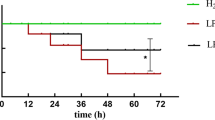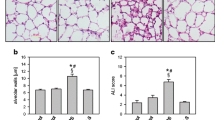Abstract
Alveolar type II epithelial cells can regulate immune responses to sepsis-induced acute lung injury. Lipopolysaccharide (LPS), an outer membrane component of Gram-negative bacteria, can cause septic shock. This study was designed to evaluate the cytotoxic effects of LPS on human alveolar epithelial A549 cells and its possible molecular mechanisms. Exposure of A549 cells to LPS decreased cell viability in concentration- and time-dependent manners. In parallel, LPS concentration- and time-dependently induced apoptosis of A549 cells. Meanwhile, LPS only at a high concentration of 10 μg/ml caused mildly necrotic insults to A549 cells. In terms of the mechanism, exposure of A549 cells to LPS increased the levels of cellular nitric oxide and reactive oxygen species (ROS). Pretreatment with N-acetylcysteine (NAC), an antioxidant, significantly lowered LPS-caused enhancement of intracellular ROS in A549 cells and simultaneously attenuated the apoptotic insults. Sequentially, treatment of A549 cells with LPS caused significant decreases in the mitochondrial membrane potential and biosynthesis of adenosine triphosphate. In succession, LPS triggered the release of cytochrome c from the mitochondria to the cytoplasm. Activities of caspase-9 and caspase-6 were subsequently augmented following LPS administration. Consequently, exposure of A549 cells induced DNA fragmentation in a time-dependent manner. Pretreatment of A549 cells with NAC significantly ameliorated LPS-caused alterations in caspase-9 activation and DNA damage. Therefore, this study shows that LPS specifically induces apoptotic insults to human alveolar epithelial cells through ROS-mediated activation of the intrinsic mitochondrion–cytochrome c-caspase protease mechanism.







Similar content being viewed by others
References
Angus DC, Linde-Zwirble WT, Lidicker J, Clermont G, Carcillo J, Pinsky MR (2001) Epidemiology of severe sepsis in the United States: analysis of incidence, outcome, and associated costs of care. Crit Care Med 29:1303–1310
Blom WM, de Bont HJ, Nagelkerke JF (2003) Regional loss of the mitochondrial membrane potential in the hepatocyte is rapidly followed by externalization of phosphatidylserines at that specific site during apoptosis. J Biol Chem 278:12467–12474
Bysani GK, Shenep JL, Hildner WK, Stidham GL, Roberson PK (1990) Detoxification of plasma containing lipopolysaccharide by adsorption. Crit Care Med 18:67–71
Cazzola M, Page CP, Matera MG (2004) Alternative and/or integrative therapies for pneumonia under development. Curr Opin Pulmonary Med 10:204–210
Chang CC, Liao YS, Lin YL, Chen RM (2006) Nitric oxide protects osteoblasts from oxidative stress-induced apoptotic insults via a mitochondria-dependent mechanism. J Orthop Res 24:1917–1925
Chang HC, Chen TL, Chen RM (2009) Interruption of hepatocyte cytoskeletons by ketamine occurs through suppression of calcium mobilization and mitochondrial function. Drug Metab Dipos 37:24–31
Chang HC, Lin KH, Tai YT, Chen JT, Chen RM (2010) Lipoteichoic acid-induced TNF-α and IL-6 gene expressions and oxidative stress production in macrophages are suppressed by ketamine through downregulating toll-like receptor 2-mediated activation of ERK1/2 and NFκB. Shock 33:485–492
Chen RM, Chou MW, Ueng TH (2000) Induction of cytochrome P450 1A1 in human hepatoma HepG2 cells by 6-nitrochrysene. Toxicol Lett 117:69–77
Chen RM, Chen TL, Chiu WT, Chang CC (2005a) Molecular mechanism of nitric oxide-induced osteoblast apoptosis. J Orthop Res 23:462–468
Chen RM, Chen TL, Lin YL, Chen TG, Tai YT (2005b) Ketamine reduces nitric oxide biosynthesis in human umbilical vein endothelial cells through downregulating endothelial nitric oxide synthase expression and intracellular calcium levels. Crit Car Med 33:1044–1049
Chen TG, Chen TL, Chang HC, Tai YT, Cherng YG, Chang YT, Chen RM (2007) Oxidized low-density lipoprotein induces apoptotic insults to mouse cerebral endothelial cells via a Bax-mitochondria-caspase protease pathway. Toxicol Appl Pharmacol 219:42–53
Chen TL, Chang CC, Lin YL, Ueng YF, Chen RM (2009) Signal-transducing mechanisms of ketamine-caused inhibition of interleukin-1β gene expression in lipopolysaccharide-stimulated murine macrophage-like Raw 264.7 cells. Toxicol Appl Pharmacol 240:15–25
Chen TL, Wu GJ, Hsu CS, Fong TH, Chen RM (2010) Oxidative stress induces apoptotic insults to rat osteoblasts by suppressing phosphorylation of mitogen-associated protein kinases, activation of nuclear factor-kappaB and activator protein-1, and subsequent Bcl-XL expression. Chem Biol Interact 184:359–365
Cherng YG, Chang HC, Lin YL, Kuo ML, Chiu WT, Chen RM (2008) Apoptotic insults to human chondrocytes induced by nitric oxide are involved in sequential events, including cytoskeletal remodeling, phosphorylation of mitogen-activated protein kinase kinase kinase-1, and Bax-mitochondria-mediated caspase activation. J Orthop Res 26:1018–1026
Cho YS, Oh SY, Zhu Z (2008) Tyrosine phosphatase SHP-1 in oxidative stress and development of allergic airway inflammation. Am J Respir Cell Mol Biol 39:412–419
Chuang CY, Chen TL, Chen RM (2009) Molecular mechanisms of lipopolysaccharide-caused induction of surfactant protein-A gene expression in human alveolar epithelial A549 cells. Toxicol Lett 191:132–139
Clements JA, Avery ME (1998) Lung surfactant and neonatal respiratory distress syndrome. Am J Respir Crit Care Med 157:S59–S66
Crouch E, Wright JR (2001) Surfactant proteins A and D and pulmonary host defense. Ann Rev Physiol 63:521–554
Ferrari R, Ceconi C, Campo G, Cangiano E, Cavazza C, Secchiero P, Tavazzi L (2009) Mechanisms of remodelling: a question of life (stem cell production) and death (myocyte apoptosis). Circ J 73:1973–1982
Fiers W, Beyaert R, Declercq W, Vandenabeele P (1999) More than one way to die: apoptosis, necrosis and reactive oxygen damage. Oncogene 18:7719–7730
Goyal L (2001) Cell death inhibition: keeping caspases in check. Cell 104:805–808
Ho WP, Chan WP, Hsieh MS, Chen RM (2009) Runx2-mediated Bcl-2 gene expression contributes to nitric oxide protection against oxidative stress-induced osteoblast apoptosis. J Cell Biochem 108:1084–1093
Hsu YT, Wolter KG, Youle RJ (1997) Cytosol-to-membrane redistribution of Bax and Bcl-XL during apoptosis. Proc Natl Acad Sci USA 94:3668–3672
Kagan VE, Borisenko GG, Tyurina YY, Tyurin VA, Jiang J, Potapovich AI, Kini V, Amoscato AA, Fujii Y (2004) Oxidative lipidomics of apoptosis: redox catalytic interactions of cytochrome c with cardiolipin and phosphatidylserine. Free Rad Biol Med 37:1963–1985
Kitchens RL, Thompson PA, Viriyakosol S, O’Keefe GE, Munford RS (2001) Plasma CD14 decreases monocyte responses to LPS by promoting the transfer of cell-bound LPS to plasma lipoproteins. J Clin Invest 108:485–493
Koh H, Tasaka S, Hasegawa N, Yamada W, Shimizu M, Nakamura M, Yonemaru M, Ikeda E, Adachi Y, Fujishima S, Yamaguchi K, Ishizaka A (2007) Protective role of vascular endothelial growth factor in endotoxin-induced acute lung injury in mice. Respir Res 8:60
Lee ST, Wu TT, Yu PY, Chen RM (2009) Apoptotic insults to human HepG2 cells induced by S-(+)-ketamine occurs through activation of a Bax-mitochondria-caspase protease pathway. Br J Anaesth 102:80–89
Lee CJ, Tai YT, Lin YL, Chen RM (2010) Molecular mechanisms of propofol-involved suppression of nitric oxide biosynthesis and inducible nitric oxide synthase gene expression in lipopolysaccharide-stimulated macrophage-like RAW 264.7 cells. Shock 33:93–100
LeVine AM, Whitsett JA, Gwozdz JA, Richardson TR, Fisher JH, Burhans MS, Korfhagen TR (2000) Distinct effects of surfactant protein A or D deficiency during bacterial infection on the lung. J Immunol 165:3934–3940
Mendelson CR (2000) Role of transcription factors in fetal lung development and surfactant protein gene expression. Ann Rev Physiol 62:875–915
Pellegrini M, Baldari CT (2009) Apoptosis and oxidative stress-related diseases: the p66Shc connection. Curr Mol Med 9:392–398
Raetz CR, Ulevitch RJ, Wright SD, Sibley CH, Ding A, Nathan CF (1991) Gram-negative endotoxin: an extraordinary lipid with profound effects on eukaryotic signal transduction. FASEB J 5:2652–2660
Rooney SA (2001) Regulation of surfactant secretion. Comp Biochem Physiol 129:233–243
Saikumar P, Dong Z, Patel Y, Hall K, Hopfer U, Weinberg JM, Venkatachalam MA (1998) Role of hypoxia-induced Bax translocation and cytochrome c release in reoxygenation injury. Oncogene 17:3401–3415
Sauter C, Wolfensberger C (1980) Interferon in human serum after injection of endotoxin. Lancet 18:852–853
Tai YT, Cherng YG, Chang CC, Hwang YP, Chen JT, Chen RM (2007) Pretreatment with low nitric oxide protects osteoblasts from high nitric oxide-induced apoptotic insults through regulation of c-Jun N-terminal kinase/c-Jun-mediated Bcl-2 gene expression and protein translocation. J Orthop Res 25:625–635
Vernooy JHJ, Mentener MA, van Suylen RJ, Buurman WA, Wouters EFM (2001) Intratracheal instillation of lipopolysaccharide in mice induces apoptosis in bronchial epithelial cells. Am J Respir Cell Mol Biol 24:569–576
Waak J, Weber SS, Waldenmaier A, Gorner K, Alunni-Fabbroni M, Schell H, Vogt-Weisenhorn D, Pham TT, Reumers V, Baekelandt V, Wurst W, Kahle PJ (2009) Regulation of astrocyte inflammatory responses by the Parkinson’s disease-associated gene DJ-1. FASEB J 23:2478–2489
Welbourn CRB, Yong Y (1992) Endotoxin, septic shock and acute lung injury: neutrophils, macrophages, and inflammatory mediators. Br J Surg 79:998–1003
Wu GJ, Chen TG, Chang HC, Chiu WT, Chang CC, Chen RM (2007) Nitric oxide from both exogenous and endogenous sources activates mitochondria-dependent events and induces insults to human chondrocytes. J Cell Biochem 101:1520–1531
Acknowledgments
This study was supported by the Department of Health, Taipei City Hospital (94002-62-005 and 95001-62-017), Taipei, Taiwan. The authors express their gratitude to Ms. Yi-Ling Lin for technical support and data collection during the experiments.
Author information
Authors and Affiliations
Corresponding author
Additional information
Chi-Yuan Chuang and Ta-Liang Chen contributed equally to this work.
Rights and permissions
About this article
Cite this article
Chuang, CY., Chen, TL., Cherng, YG. et al. Lipopolysaccharide induces apoptotic insults to human alveolar epithelial A549 cells through reactive oxygen species-mediated activation of an intrinsic mitochondrion-dependent pathway. Arch Toxicol 85, 209–218 (2011). https://doi.org/10.1007/s00204-010-0585-x
Received:
Accepted:
Published:
Issue Date:
DOI: https://doi.org/10.1007/s00204-010-0585-x




